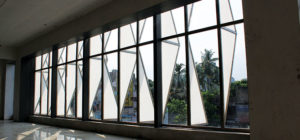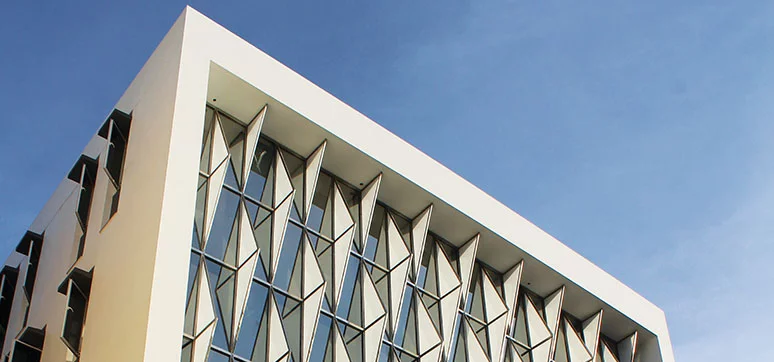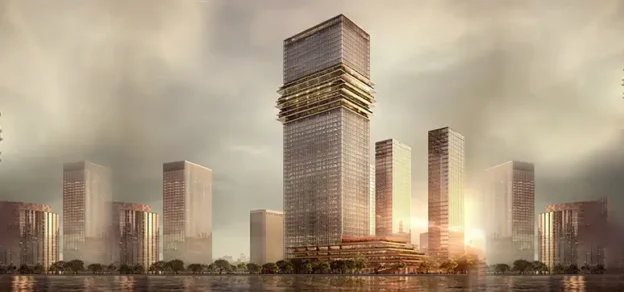Arcot Plaza at Chennai is designed to be a sustainable business centre which offers worldclass commercial spaces for its users on an affordable budget. The Architectural Design of the building was a direct response to the climate. The building has an iconic presence on the street and due to the iconic design fetched higher rent per Sq ft. Also, the building consumes 15 percent less energy due to the climate-sensitive design features which reduce the life-cycle cost of the building.

Client Brief: The site (8000 Sq ft.) was located in one of the major arterial roads of Chennai – Arcot Road. The client brief was to create a multitenanted commercial building which would serve the banking sector in the area and maximise the economic potential of the site. The building needed to have an iconic presence in the streetscape of Chennai.
Architect’s Interpretation: Usually commercial buildings in third-world cities like Chennai are energy-guzzlers with unplanned service lines all over, with fully glazed windows trapping the heat, AC units dripping on the users, poorly organised circulation and are major fire-hazards. Arcot Plaza was designed after detailed research on the shortfalls of such commercial centres. It was designed to be a sustainable business centre which offered world-class commercial spaces for its users.

From the inception of the project, care was taken to address the user comfort and ensure the sustainable use of natural resources during its construction and life cycle. The building satisfies all the local bye-laws applicable as per the municipal master plan. It serves to upgrade the availability of Grade-A commercial spaces in the micro-market of Kodambakkam.
The Design: The idea was to maximise the visibility of the building and tap the potential in terms of footfall as the site is located between the existing railway station and an upcoming metro station. The ground plane was designed as a public zone. The front edge of the site was designed as a public plaza extending the pedestrian sidewalk into the site with the building having an inviting double-height atrium for the retail branch. The office floors have a separate entrance lobby at the rear with a vehicular drop-off. The terrace was designed to accommodate a large terrace garden which cuts the heat load of the offices and provides a breakout space for the office workers.

Sustainability: The form of the building was a direct response to the climate. The northern side faces the street. Care was taken to protect the glass frontage of the building with appropriate and innovative shading devices thereby providing effective daylighting and reducing the solar heat gain on the building. The retail façade is protected by the office floors cantilevering from above. The western and eastern sides has been designed with appropriate openings to facilitate cross-ventilation inside.

The building is designed to harvest 100 per cent of the rainwater. Provisions have been planned for grey-water recycling to reduce the requirement of the building on metro water. Solar energy use is planned for common areas. The walls are made of AAC blocks which have superior thermal insulation over bricks and is also more cost-effective as it reduce the dead-load of the building.
Low-maintenance materials have been used which reduce the amount of energy spent on cleaning the building. Also, most materials are locally available making replacements cheaper and easily available.
Innovative Day-Lighting Facade: The northern façade of the building for the office floors was designed to give glare-free daylighting for the workspaces. The triangulated translucent polycarbonate fins placed in carefully determined patterns cut the direct sunlight.

In Chennai, during summer the setting sun moves northward. During such months the fins provide diffused light. During other times they cut the glare from the bright sky. It also offers an interesting view of the street from the office spaces breaking the monotony of the spaces. Also, the glass used is solar-rated glass to cut heat gain. The exploded diagram explains the façade construction system.
The Success: The building has an iconic presence on the street and due to the sensitive design fetched higher rent per Sq ft. Also, the building consumes 15 per cent less energy due to the climate-sensitive design features which reduce the life-cycle cost of the building.

Some of the design objectives achieved through the project are:
• Maximise site visibility by creating a public plaza and an iconic form
• Creation of an iconic building with the lowest possible budget
• Natural light without glare for office spaces
• Solar passive design with appropriate shading features
• Climate-responsive design with lower heat gain
• Maximum visibility for retail spaces with higher foot-falls
• Achieve maximum revenue potential
Quick Facts
Project: Arcot Plaza
Location: Kodambakkam, Chennai
Client: Individual
Architect: Architecture Plus Value
Principal architect: V.S. Vigneswar
Type: Commercial building (Business centre)
Usage: Multi-tenant banking (retail branch + back office)
Materials used for façade & fenestration: Custom
fabricated stainless steel mullions, solar-rated glass
(ST-167), polycarbonate fins with SS frame, clear silicon
sealant
Site Area: 8000 Sq ft.
Built Area: 16,000 Sq ft.
Commencement date: September 2013
Completion date: November 2016














